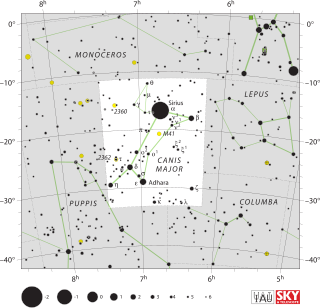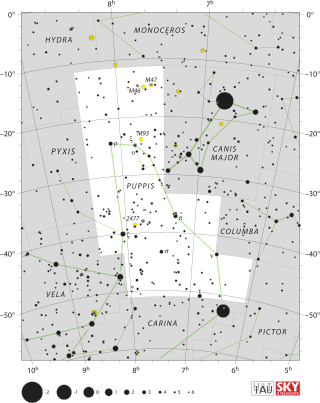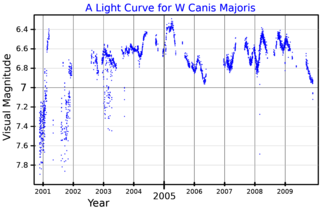
Canis Major is a constellation in the southern celestial hemisphere. In the second century, it was included in Ptolemy's 48 constellations, and is counted among the 88 modern constellations. Its name is Latin for "greater dog" in contrast to Canis Minor, the "lesser dog"; both figures are commonly represented as following the constellation of Orion the hunter through the sky. The Milky Way passes through Canis Major and several open clusters lie within its borders, most notably M41.

Eta Canis Majoris, also named Aludra, is a star in the constellation of Canis Major. Since 1943, the spectrum of this star has served as one of the stable anchor points by which other stars are classified.

Beta Canis Majoris, also named Mirzam, is a star in the southern constellation of Canis Major, the "Great Dog", located at a distance of about 500 light-years (150 parsecs) from the Sun. In the modern constellation it lies at the position of the dog's front leg.

Iota Canis Majoris, Latinized from ι Canis Majoris, is a solitary variable supergiant star in the southern constellation of Canis Major. It is visible to the naked eye with an apparent visual magnitude that varies between +4.36 and +4.40. The distance to this star is approximately 2,500 light years based on spectroscopic measurements. It is drifting further away with a radial velocity of +42 km/s.

Kappa Canis Majoris, Latinized from κ Canis Majoris, is a solitary, blue-white hued star in the constellation Canis Major. It is visible to the naked eye with an apparent visual magnitude of +3.87. Based upon an annual parallax shift of 7.70 mas as seen from Earth, this star is located about 660 light years from the Sun.

Omicron1 Canis Majoris is a red supergiant star in the constellation Canis Major. It is also a variable star.

Sigma Canis Majoris, also named Unurgunite, is a variable star in the southern constellation of Canis Major. It is approximately 1,290 light-years from the Sun and has an average apparent visual magnitude of +3.41.

Omega Canis Majoris, Latinized from ω Canis Majoris, is a solitary, blue-white-hued star in the equatorial constellation of Canis Major. It is visible to the naked eye with an apparent visual magnitude of about 4. Based upon an annual parallax shift of just 3.58 mas as seen from Earth, this system is located roughly 910 light-years from the Sun.

10 Canis Majoris is a single variable star in the southern constellation of Canis Major, located roughly 1,980 light years away from the Sun. It has the variable star designation FT Canis Majoris; 10 Canis Majoris is the Flamsteed designation. This body is visible to the naked eye as a faint, blue-white hued star with a baseline apparent visual magnitude of 5.23. It is moving away from the Earth with a heliocentric radial velocity of +34 km/s.

12 Canis Majoris is a variable star located about 707 light years away from the Sun in the southern constellation of Canis Major. It has the variable star designation HK Canis Majoris; 12 Canis Majoris is the Flamsteed designation. This body is just barely visible to the naked eye as a dim, blue-white hued star with a baseline apparent visual magnitude of +6.07. It is moving away from the Earth with a heliocentric radial velocity of +16 km/s. This is the brightest star in the vicinity of the open cluster NGC 2287, although it is probably not a member based on its proper motion.

UW Canis Majoris is a star in the constellation Canis Major. It is classified as a Beta Lyrae eclipsing contact binary and given the variable star designation UW Canis Majoris. Its brightness varies from magnitude +4.84 to +5.33 with a period of 4.39 days. Bode had initially labelled it as Tau2 Canis Majoris, but this designation had been dropped by Gould and subsequent authors.

EZ Canis Majoris is binary system in the constellation of Canis Major. The primary is a Wolf-Rayet star and it is one of the ten brightest Wolf-Rayet stars, brighter than apparent magnitude 7.

VY Canis Majoris is an extreme oxygen-rich red hypergiant or red supergiant and pulsating variable star 1.2 kiloparsecs from the Solar System in the slightly southern constellation of Canis Major. It is one of the largest known stars, one of the most luminous and massive red supergiants, and one of the most luminous stars in the Milky Way.

NR Canis Majoris is a binary star system in the southern constellation of Canis Major, located to the east of Sirius and Gamma Canis Majoris near the constellation border with Puppis. It has a yellow-white hue and is dimly visible to the naked eye with a combined apparent visual magnitude that fluctuates around 5.60. It is located at a distance of approximately 297 light years from the Sun based on parallax. The system is drifting closer to the Sun with a radial velocity of −29 km/s, and in about three million years it is predicted to approach within 14.1+4.7
−4.0 ly. At that time, the star will become the brightest in the night sky, potentially reaching magnitude −0.88.

Mu Canis Majoris is a binary star system in the southern constellation of Canis Major. The pair can be located a little to the southwest of the point midway between Gamma and Theta Canis Majoris, and the components can be split with a small telescope. The system is faintly visible to the naked eye with an apparent visual magnitude of 5.12. Based upon an annual parallax shift of just 2.62 mas as seen from Earth, this system is located roughly 1,200 light years from the Sun.

Omicron Puppis (ο Puppis) is candidate binary star system in the southern constellation of Puppis. It is visible to the naked eye, having a combined apparent visual magnitude of +4.48. Based upon an annual parallax shift of 2.30 mas as seen from Earth, it is located roughly 1,400 light years from the Sun.

W Canis Majoris is a carbon star in the constellation Canis Major. A cool star, it has a surface temperature of around 2,900 K and a radius 234 times that of the Sun, with a bolometric absolute magnitude of −4.13 and distance estimated at 443 or 445 parsecs based on bolometric magnitude or radius. The Gaia Data Release 2 parallax of 1.8049±0.1454 milliarcseconds implies a distance of about 555 parsecs.

FS Canis Majoris (FS CMa), also known as HD 45677 or MWC 142, is a B-type star in the constellation of Canis Major. It has an apparent visual magnitude of approximately 8.50, having varied between magnitudes 7.35 and 8.58. Feinstein and colleagues reported in 1976 that it had decreased by 0.9 magnitude between 1969 and 1976, whereas it had only varied by 0.3 magnitude in the 70 years beforehand. Sometimes it could vary by up to 0.5 magnitude in a year or 0.1 magnitude in a night, and there did not appear to be any regular period to its variability.

UX Ursae Majoris is an Algol type binary star system in the northern circumpolar constellation of Ursa Major. It is classified as a nova-like variable star similar to DQ Herculis, although no eruptions have been reported. Since its discovery in 1933, this system has been the subject of numerous studies attempting to determine its properties. The combined apparent visual magnitude of UX UMa ranges from 12.57 down to 14.15. The system is located at a distance of approximately 952 light years from the Sun based on parallax, and is drifting further away with a radial velocity of 112 km/s.

HR 2501, also known as HD 49131 and HP Canis Majoris, is a star about 2,000 light years from the Earth, in the constellation Canis Major. It is a 5th magnitude star, so it will be faintly visible to the naked eye of an observer far from city lights. It is a variable star, whose brightness varies from magnitude 5.35 to 5.80 on a variety of timescales ranging from hours to hundreds of days.











